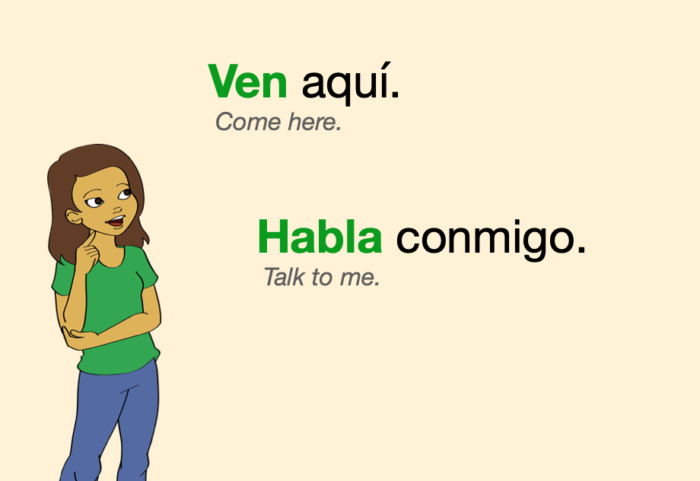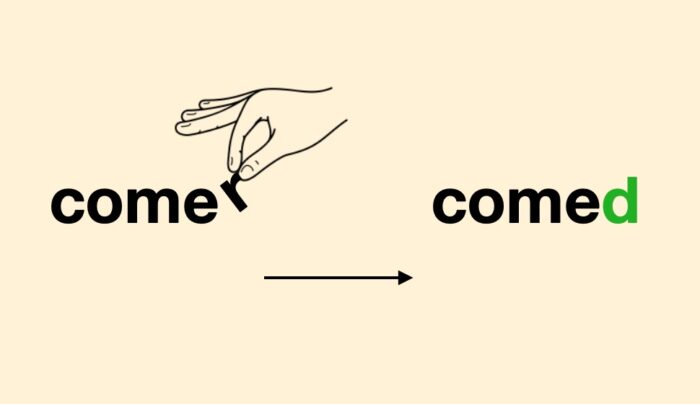Welcome 😊 to our grammar lesson on how to give affirmative informal commands in Spanish.
These are commands in which we tell one person (“tú”) or several people (“vosotros”) to do something.

By the end of this lesson, you will be able to give these commands using the correct verb forms.
You will also find a Quiz and Exercises to practice.
Important: In this lesson we are only talking about affirmative informal commands.
If you want to learn negative and/or formal commands, click here
“tú” commands
Regular forms
Most verbs have a regular “tú” command, and it is identical to the “él” form in Present Tense.
Examples:
to eat to work to live to close to sleep to ask for
Verb "él" form in Present Tense "tú" command
comer come come
trabajar trabaja trabaja
vivir vive vive
cerrar cierra cierra
dormir duerme duerme
pedir pide pide
Example sentences:
Habla conmigo, por favor.
Talk to me, please.Bebe menos.
Drink less.Come más.
Eat more.Juega conmigo a las cartas.
Play cards with me.Por favor, cierra las ventanas.
Please close the windows.Pide una cerveza.
Order a beer.
Irregular forms
Some verbs have an irregular “tú” command. Here are the most important ones:
to be to go to have to come to do to say to put to get out
Verb "tú" command
ser sé
ir ve
tener ten
venir ven
hacer haz
decir di
poner pon
salir sal
Example sentences:
Pon la mesa.
Set the table.Ven aquí, por favor.
Come here, please.Di la verdad.
Tell the truth.Sal de tu habitación y haz algo.
Get out of your room and do something.
“vosotros” commands
“vosotros” commands are all regular, even for verbs with irregular “tú” commands.
To form a “vosotros” command, simply replace the verb’s final “r” with a “d”:

Examples:
to eat to speak to close to sleep to do to say to put to get out
Verb "vosotros" command
comer comed
hablar hablad
cerrar cerrad
dormir dormid
hacer haced
decir decid
poner poned
salir salid
Example sentences:
Comed pasta.
Eat pasta. (you guys)Abrid la puerta, por favor.
Open the door, please. (you guys)Haced vuestras camas.
Make your beds. (you guys)Tened paciencia.
Have patience. (you guys)Decid vuestros nombres.
Say your names. (you guys)
Placement of reflexive and object pronouns
In order to add reflexive or object pronouns (me, te, lo, le, la, los, las, nos, os, se…) to an affirmative command, just attach the pronoun at the end of the verb form:
Ponlo aquí.
Put it here.Llámanos pronto.
Call us soon.Llamadnos pronto.
Call us soon. (you guys)Usadlo.
Use it. (you guys)
If we want to include two of these pronouns, we attach them one after another:
Dámela.
Give it to me.Cómpranoslo.
Buy it to us.Mandádmela.
Send it to me. (you guys)
Accent marks when we attach pronouns
– “tú” commands may get an accent mark when we attach one or more pronouns, specially if the resulting word is long. The accent mark might be on the word’s 3rd or 4th vowel (counting from right to left).
Example: Llámanos
– “vosotros” commands never get an accent mark when we attach one pronoun, but always get an accent mark when we attach two pronouns. The accent mark must be on the 3rd vowel (counting from right to left).
Example: Mandádmela
Special case – attaching “os” to a “vosotros” command
If we attach the pronoun os at the end of a “vosotros” command, the command loses its final “d”.
This happens with reflexive verbs like “ducharse”, “levantarse”, “concentrarse”…:
Duchaos, por favor.
Take a shower, please. (you guys) – Not “duchados”, because the command loses its final “d”.Levantaos.
Get up. (you guys) – Not “levantados”.Concentraos.
Concentrate. (you guys) – Not “concentrados“
Practice
Quiz
Take this short Quiz about affirmative informal commands:
Exercise 1
Make “tú” commands for the following verbs. Click on the gray spaces to see the solutions:
1) escuchar – escucha
2) leer – lee
3) contar – cuenta
4) repetir – repite
5) decir – di
6) salir – sal
7) tener – ten
8) hacer – haz
Exercise 2
Now for those same verbs, make “vosotros” commands.
1) escuchar – escuchad
2) leer – leed
3) contar – contad
4) repetir – repetid
5) decir – decid
6) salir – salid
7) tener – tened
8) hacer – haced
Exercise 3
A mother gives her son Juanito several commands.
Fill the gaps with the “tú” commands of the verbs in brackets:
1) Juanito, haz tu cama. (hacer)
Juanito, make your bed.
2) Limpia tu habitación. (limpiar)
Clean your room.
3) Prepara tu mochila. (preparar)
Pack your backpack.
4) Di qué has hecho hoy en clase. (decir)
Say what you did in class today.
Exercise 4
A mother gives commands to her children.
Fill the gaps with the “vosotros” commands of the verbs in brackets:
1) Niños, haced las tareas. (hacer)
Children, do your homework.
2) Por favor, venid y ayudad a limpiar la cocina. (venir, ayudar)
Please come and help clean the kitchen.









